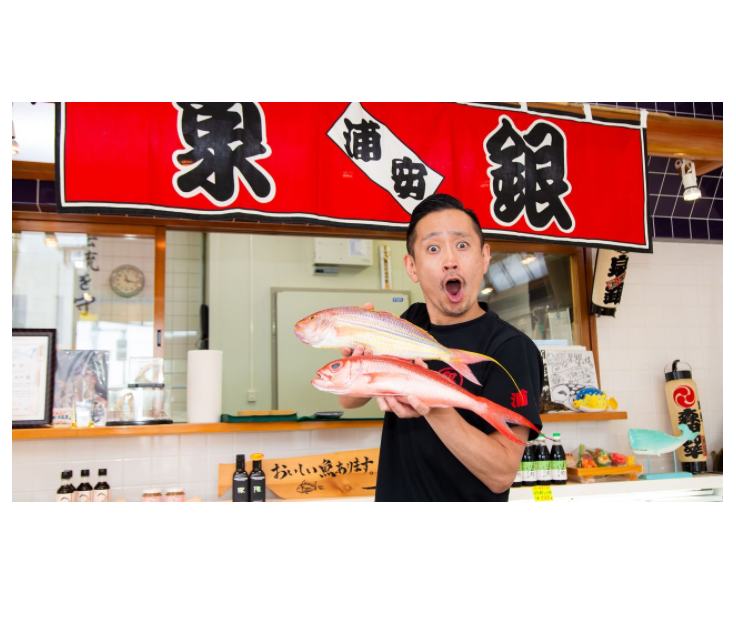英文解読練習として英語のニュースから日本語に翻訳された記事をよく読んでいますか?このコーナーではそんな世界の面白いニュースとその日本語訳をピックアップしてご紹介します。リーディングや外国人に話しかける時にも、緊張をほぐして、会話のきっかけとしていかがですか?
英語:““Eat More Fish!”: Japan’s Rock-and-Roll Fishmonger Crusades for Traditional Mealtime Staple”
Japan has one of the highest life expectancy rates in the world, and one reason for this is its seafood-rich diet. Seafood has been a major source of protein for the Japanese people for centuries. However, meat has since taken over as a culinary favorite. According to the Ministry of Agriculture, Forestry, and Fisheries, per capita fish consumption peaked at 40.2 kilograms in 2001, but was still far ahead of meat at 27.8 kilograms. Japanese preferences, particularly among young people, have since verged away from fish and other seafood, and in 2011, seafood consumption dropped below that of meat for the first time. By 2019, annual per capita seafood consumption had fallen to 23.8 kilograms, while meat increased to 33.5 kilograms. In addition to sluggish demand, catches of staple fish varieties like saury, salmon, and squid continue to decline, constituting a double whammy for the seafood industry. Once a major fishery nation, Japan is seeing a major transformation of its culinary culture.
One fishmonger in Chiba Prefecture is trying to reverse the tide with the passionate cry of “eat more fish!”
Songs of Fish and the Sea
Morita Tsurizao, the third-generation proprietor of Urayasu fish shop Izugin, is on a rock-and-roll mission. Going by his stage name—Tsurizao literally means “fishing rod”—he leads the musical group Gyokō (Fishing Port) that offers a new kind of music Morita calls “fish rock.” In 2004, the band made their debut on major label Universal Music with the song “Maguro” (Tuna).
Morita, who fellow members and fans call “Captain,” is the group’s vocalist and song writer. He pens tunes singing the praises of fish, the ocean, and fishermen. The group’s live performances are embellished with dramatic tuna-carving shows and other attractions to thrill fans and emphasize the band’s message: “Eat fish!”
When not on stage, Morita is selling fresh fish and other seafood at his store. He used to specialize in tuna and whale meat at the Urayasu Fish Market, but after the market closed, he opened shop in the Horie district of the city. He says selling fish is his true livelihood and passion and even confesses to turning down an invitation for his group to perform in New York, stating that “I just couldn’t keep the shop closed that long.”
Reviving a Fishing Town
Not far from Izugin on the opposite side of the Sakai River is the neighborhood of Nekozane. The area’s reputation as a fishing town stretches back hundreds of years. Morita says that when he was a child, the riverbank was lined with fish shops, but that today the incursion of supermarkets and other changes have caused their numbers to dwindle.
“I was a second-grader when Tokyo Disneyland opened in Urayasu, altering the landscape completely,” Morita recalls “Convenience stores popped up here and there, and I remember being amazed that you could buy rice balls just about anywhere.” He notes that the popularity of fast food and items like instant cup noodles have drastically changed the Japanese diet, although he insists that this is a temporary state of affairs. “The Japanese preference for fish is something rooted in our very being. After all, this used to be a fishing town and people here used to eat a lot of fish.”
In the old days, fish shops were centers of community activity, serving as places for locals to share news or engage in casual chit-chat as they looked over the day’s catch. Morita is determined to revive that friendly atmosphere by making it a point to talk with his customers.
“The special you recommended the other day was delicious,” a customer tells him. “If you liked it,” responds Morita, his voice trained for singing clear and pleasant, “I suggest you try the matōdai [John dory] today. It can be eaten as sashimi and makes a great carpaccio. Leave the skin on the remaining half and sauté it with a meunière sauce. Delicious!”
Morita sources the wide assortment of fish and seafood he offers at Izugin through relatives and friends working in the Toyosu wholesale market in Tokyo. The store’s offerings are quite different from those of the average fish shop. “Knowing you’re eating a rare delicacy makes it all the more delicious,” Morita declares. Not only does Izugin offer a diverse variety of fish, but it also sells unusual items like juicy “cheek” meat, tail meat, skin, and even brains of tuna. And if you don’t know how to prepare such tasty morsels, Morita will teach you everything from arrangement to seasoning.
“Tuna brain is fatty and particularly tasty,” Morita says. “Cheek meat is also savory. And the tail meat is rich in collagen. Even the skin can be tasty if you prepare it well.” He recommends scalding pieces of skin in boiling water flavored with sake and ginger, scraping off the scales, letting the pieces cool, and then slicing them into fine strips. “Dribble on some ponzu, top with daikon radish grated with a little bit of chili pepper, drop on a few chopped chives, then add a dash of Tabasco to give it an extra zing.”
Copyright 2020 Nippon Communications Foundation
原文を読む≫
日本語:“自分でさばいて「魚食え、コノヤロー!!」:浦安のロックな魚屋・森田釣竿氏”
世界に誇る長寿国・ニッポン。その要因の一つとされるのが、和食の代表格「魚食」だ。肉食を禁忌とした江戸時代を経て、近年まで日本人にとっての主なタンパク源は魚であった。農林水産省「食料需給表」によると、年間の1人当たりの魚介類消費量は、ピークだった2001(平成13)年には40.2キロで、肉類の27.8キロを大きく引き離していた。それが若者を中心に「魚離れ」が進み、2011年以降は肉を下回るようになり、2019年は肉類の33.5キロに対して23.8キロまで落ち込んだ。需要の低迷に加え、漁獲高の面でもサンマやサケ、イカなどが不漁続きで、水産業界にとってはまさにダブルパンチ。かつて水産大国だった日本の「食」が、その姿を大きく変えつつある。
そうした中、「魚食え、コノヤロー!!」とシャウトし、魚食復権に情熱を燃やす魚屋さんが今、注目を集めている。
魚や海の曲でメジャーデビュー
千葉県浦安市の鮮魚店「泉銀」の3代目・森田釣竿氏(本名非公表)は、「フィッシュロック」と銘打った新たな音楽ジャンルを打ち出し、「漁港」(港は左右反転)というバンドを結成。2004年には『鮪(まぐろ)』をテーマにした曲で、ユニバーサルミュージックからメジャーデビューを果たした。
ボーカル兼リーダーを務め、メンバーやファンからは「船長」と呼ばれる。これまで魚や海、漁師にちなんだ、水産業の応援歌ともいえる曲を数多く手掛けてきた。ライブでは、マグロの解体ショーなど豪快なパフォーマンスを織り交ぜてファンを魅了。同時に最大のメッセージである「魚食のススメ」によって、魚好きを増やしてきた。
一方、本業は鮮魚店経営。かつては「浦安魚市場」内の店舗を拠点に、マグロやクジラに特化して販売していたが、同市場の閉場もあって現在は浦安市内の堀江地区で、幅広い水産物を扱う鮮魚店・泉銀を切り盛りしている。あくまでも本業優先で、「そんなに長く店を休んでられない」と、ニューヨークでのライブ出演の誘いを断ったことまであるという。
魚の町だった「かつての浦安を取り戻したい」
泉銀のある堀江、境川をはさんで対岸の猫実(ねこざね)は、江戸時代から漁師町として知られた場所。釣竿氏が子どもの頃は、地元に鮮魚店が何十軒もあったが、スーパーなどの台頭で今では数少ない。
「小学2年生のとき、東京ディズニーランドができて町は一変した。コンビニがあちこちにできて、手軽におにぎりを買って食べられるようになったのは驚いたね。カップラーメンやハンバーガーなどファストフードも浸透し、大人まで飛びついたから、日本人の食は大きく変わってしまった、でも表向きの食生活が変化しても、やっぱり魚好きのDNAは残っていると思う。特に漁師町のこの辺りでは、昔から魚をたくさん食べていたからね」(釣竿氏)
ふらっと立ち寄り、一言二言交わしながら気軽に魚を買う――。そんな昔ながらの鮮魚店を復活させたいと、釣竿氏は積極的に客に話し掛ける。バンドで鍛えた声はよく通り、なんとも小気味いい。
「この間のミンククジラ、最高だったよ」(客)
「なら今日は、マトウダイがお薦めだよ。刺し身で食べるなら、カルパッチョにするといい。残り半分は皮付きのままムニエルなんてのもうまい」(釣竿氏)。
親戚や友人が経営する豊洲市場の仲卸から仕入れる泉銀の品ぞろえは、一般的な鮮魚店とは明らかに違う。釣竿氏は「珍しい魚がおいしいと分かれば、よりうれしいでしょ」ときっぱり。魚の種類だけではなく、例えばマグロなら脳天やホホ肉、尾肉、皮など希少部位が並ぶ。調理法が分からなくても心配無用だ。下ごしらえの仕方から、合わせる調味料まで、次から次へとアドバイスが飛び出してくる。
「脳天は脂が乗っていてうまいし、ホホ肉の食感は最高。尾肉はコラーゲンたっぷりでいいね。皮だってちょっと手を掛ければ、うまいつまみになるよ。沸騰させた湯に酒とショウガを少々。そこへ皮を入れて、さっと煮てからウロコを取り、冷まして硬くなったとこで細切りにして、ポン酢ともみじおろしにアサツキ。タバスコの辛味も意外と合うよ」
Copyright 2020 Nippon Communications Foundation
原文を読む≫
